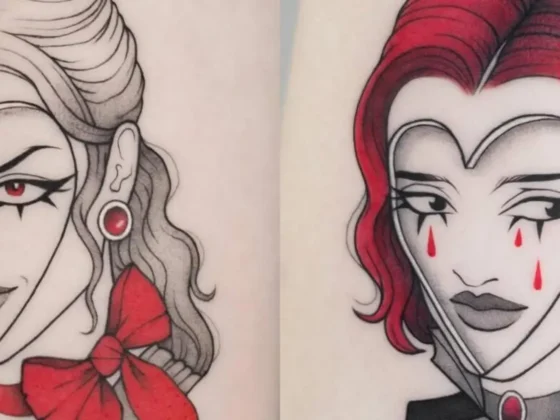Devon Preston
November 21st, 2019
Meet the South African Artist Who’s Collaborated with Nike and Coca-Cola
Illustrator Karabo Poppy talks preserving the African aesthetic in art and the inspiration behind her favorite tattoo
For many artists, their hometown, state or country plays a significant role in the work they create. Take Steven King for example, who has used New England as the setting for almost all of his stories. There’s a number of reasons why an artist might take inspiration from where they grew up, whether it be nostalgia or simply pride. But for South African illustrator and artist Karabo Poppy Moletsane, she’s pushing to boost and preserve the African aesthetic through her work. And based on her global collaborations with Nike, Coca-Cola, Bombay Sapphire, and Ponds—we’d say her message is making its rounds.
What was your upbringing like and how did that lead you to become an artist?
I grew up in a small mining town called Vereeniging in South Africa. I wasn’t exposed to much art growing up and art wasn’t something that was encouraged or celebrated by those around me. I remember always having a fascination around art but had trouble figuring out my place within the industry and having parents that disapproved of a career in art wasn’t very helpful either.
I ended up moving to Pretoria and studying visual communication. I recall studying copious amounts of artists, movements, and theories but very few portrayed a contemporary African narrative—the one I grew up around, the one that my family, neighbors, and friends encompassed. The new media I was consuming digitally was incredible but lacking in a contemporary African narrative especially that originating from South Africa.
This was the case for me growing up on The Simpsons, Futurama, Mortal Combat, etc, and it was shocking to me to see this was still the case in my 20s. I remember that the only real place I saw art or media that represented a familiar narrative was on the walls of barbershops and hair salons in my neighborhood. I set out to make my narrative part of digital media through my illustration and art I create often pays homage to the barbershops and hair salon signage.
What led me to become an artist was the desire to see a contemporary African Aesthetic represented more in media. I set out to contribute by creating art that I wished to see in the world and believed that other Africans longed to see more of.
How does South Africa impact the art you create?
I’m inspired by the visual aesthetic of South Africa, both contemporary and traditional. Our aesthetic has a long, rich heritage rooted in constant innovation and hybridity. I believe that every South African carries this with them daily and I believe that it’s in every day seemingly mundane events where this aesthetic is at its most beautiful to me. So I set out to preserve and celebrate it in my work and represent the unrepresented. I often illustrate everyday South Africans in a traditional barbershop signage style with elements of everyday life in South Africa, but I try and portray it in new ways.
What are some specific trademarks or symbols of traditional art found in South Africa?
Well, South Africa has 12 official languages. That brings with it a myriad of different cultures that form “traditional South Africa.” Each culture has its own symbols, so it would be near impossible to come up with a list of trademarks or symbols that would really do traditional art in South Africa justice. So, I’ll name trademarks and symbols that are my favorites; South Africa has a history of beautiful and bold geometric pattern work, many bold and bright colors, unconventional tools and canvases, as well as, a desire to tell stories of home and tradition. Traditional South African art is a combination of sacred, decoration, function and entertainment.
What is the street art culture like in Johannesburg and what significance does art hold in the community?
The street art culture in Johannesburg is still in the early stages of growth, but we are seeing incredible artists exploring street art more and bringing something new, not just in Johannesburg but to the world. The early stages are great because it embraces new artists and encourages the “never before seen.”
How were you approached about collaborating with Nike?
I received a phone call from someone at Nike Africa to prepare me for the call that would come from Nike Global, where they briefed me on the collaboration and to gauge my interest in it.
Why is it important to preserve the African aesthetic through art?
I believe that it is important to preserve the African Aesthetic through art because this is a medium that is extremely accessible to many people. In order to achieve the goal of accurately representing the African Aesthetic for us and the generations to come, it’s important to use a medium that is accessible, memorable and thanks to technology can be kept safe for future generations to learn about, learn from and be proud of.
Why do you think that it’s important for people with African heritage around the world to be represented in art?
Well, I believe that it’s important to represent all people in art, but I believe there should be more attention paid to people with an African heritage. This has been a group that has been grossly underrepresented or misrepresented in the past. Recently, there has been a great transformation, where we are seeing more accurate representation in art and by artists of African heritage. African representation in art is beautiful, inspiring, educational and sparks necessary conversations, even to those without an African heritage.
What stories do your tattoos tell and what’s your most meaningful piece?
My tattoos tell a story of feminine strength, a strength that has tremendous beauty, endurance, genius, creativity, and fearlessness. My most meaningful piece is also my most painful piece, the hand tattoo I got in 2018. I see my hands as the tools I use most to fulfill my purpose, serve people, express creativity and show affection. I thought to honor these hard workers by decorating them and my next handpiece is coming soon.
What defines you as both a brand and an individual?
What defines me as both a brand and an individual is the continuous desire to break boundaries and test limits.
Editor's Picks
Chris Brown’s Face Tattoo Shows His Heart and Sole
Chris Brown has a brand new tattoo! Long gone are the days of the baby faced teen, Brown is all grown up and has the tattoo collection to prove it!…
Oh Me, Oh My
Chrissy Chlapecka on finding her voice, spreading self-love on TikTok and releasing her first single













